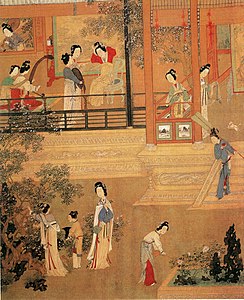Konghou
This article needs additional citations for verification. (April 2021) |
 | |
| String instrument | |
|---|---|
| Classification | chordophone |
| Related instruments | |
|
Çeng Harp | |
The konghou (simplified Chinese:箜篌; pinyin:kōnghóu Jyutping: Hung1Hau4 ) is a Chinese harp. In ancient china, konghou refers to three different musical instruments. Today's konghou usually refers to shu-konghou and the modern konghou improved in the last century.
History[]
There are three types of konghou, they all look different.
The wo-konghou (卧箜篌) or horizontal konghou, was first mentioned in written texts in the Spring and Autumn period (770–476 BC). Archeological finds show details of construction; for instance, the soundboxes were carved from diversiform-leaved poplar.[1] It is one of the oldest Chinese musical instruments, similar to guqin and se. The wo-konghou was used to play yayue (court music) in the Kingdom of Chu. During the Han Dynasty (206 BC–220 AD) the konghou was used in the qingshangyue genre. This instrument first used the name of konghou, but it has nothing to do with harp. Today, the Chinese no longer use it.
The shu-konghou(竖箜篌) or vertical konghou first appeared in the Eastern Han Dynasty (25–220 AD). It can be divided into big and small. The wo-Konghou playing was most prevalent in the Sui and Tang dynasties. It was generally played in rites and ceremonies and gradually prevailed among the ordinary people. It is also the most common type of konghou in Chinese cultural relics,murals and poetry. The Chinese harp refers to this kind of shu-konghou.
The phoenix-headed konghou(凤首箜篌) was introduced from India in the Eastern Jin Dynasty (317–420 AD). Beginning in the Sui Dynasty (581–618),It was also used in yanyue (banquet music). The instrument became extinct sometime in the Ming Dynasty.
Modern konghou
This is a new musical instrument which appeared in the 20th century and is different from the ancient konghou, but its shape is similar to Western concert harps.
The main feature that distinguishes the contemporary konghou from the Western harp is that the modern konghou's strings are folded over to make two rows, which enables players to use advanced playing techniques such as vibrato and bending tones. Paired strings on opposite sides of the instrument are tuned to the same note. They start from a tuning peg and beyond the playing area travel over two bridges on opposite sides of the instrument, and are then fixed at the far end to opposite sides of a freely moving lever so that depressing one of the string pairs raises the pitch of the other. The two rows of strings also make it suitable for playing swift rhythms and overtones.
Today, konghou is usually referred to as shu-konghou and modern modern konghou.
In other places[]
The konghou was adopted in the ancient times in Korea, where it was called gonghu (hangul: 공후; hanja: 箜篌), but it is no longer used there.
The wo-konghou is called kudaragoto (百済琴 / くだらごと) and shu-konghou was called kugo (箜篌 / くご) in Japan. the kudaragoto or kugo of Japan was in use in some Togaku (Tang music) performances during the Nara period, but seems to have died out by the 10th century. It has recently been revived in Japan, and the Japanese composer Mamoru Fujieda has composed for it.[2] Tomoko Sugawara commissioned a playable kugo harp from builder Bill Campbell and earned an Independent Music Awards nomination for her 2010 album, Along the Silk Road, playing traditional and newly written works for the instrument.
Gallery[]

Konghou, Northern Wei Dynasty, 386–535

Konghou, tomb of Wei Guizhen, 597–665 AD

Konghou (left) and guqin, Tang dynasty (618–907), unearthed in Jiuquan. Museum of Gansu Province.

Konghou from silk painting by Qiu Ying (1494–1552), "Spring Morning in the Han Palace"

Vertical konghou

Music playing in the tomb of Princess Yan

Ancient Chinese instrumentalists

Phoenix-headed konghou (a type of harp), Tang dynasty (618-907). Presumably a reconstruction.

Woman playing konghou, details of a painting by Qiu Ying, Ming Dynasty

Konghou in women's sketching in Ming Dynasty

konghou in color-painted Relief Scene of Musicians Playing (Five Dynasties,China)

Modern Western-influenced concert konghou, 2017
References[]
- ^ "Reflection upon Chinese Recently Unearthed Konghous in Xin Jiang Autonomous Region" by Xie Jin.
- ^ [1] Archived May 18, 2007, at the Wayback Machine
External links[]
| Wikimedia Commons has media related to Konghou. |
| Wikimedia Commons has media related to Kugo. |
- Chinese musical instruments
- Harps











